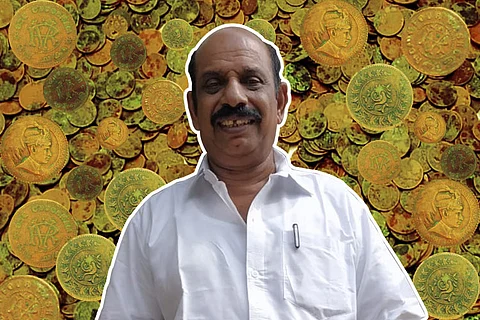

It was only last January that Lady Luck flashed a wide grin at 66-year-old B Rathnakaran Pillai, showering him with a Christmas bumper lottery win of Rs 6 crore.
The former ward member and resident of Kilimanoor for the last 40 years had always prided himself on his green thumb and decided to use a part of his lottery wins to buy land to grow vegetables.
Within a few months, he purchased 27 cents of fertile land, a few kilometres from his house in Thiruvananthapuram’s Kilimanoor. This piece of earth lay next to an old Krishna temple, known as the Thirupalkadal Sri Krishna Swami Kshethram.
However, little did Pillai know then that the very next year he would find treasure again. This time, riches from the erstwhile Kingdom of Travancore buried under the land he bought next to the temple and waiting a 100 years to be found.
On Tuesday morning, Pillai was tilling this plot to sow maricheeni or tapioca when his shovel struck a hard surface right below the soft top soil.
“I pulled out an earthen pot. Inside this were thousands of copper coins which I later realised were ancient currency from the erstwhile Kingdom of Travancore,” Pillai tells TNM.
A total of 2,595 ancient coins, weighing 20 kg and 400 grams, were counted from the earthen pot found by Pillai. Despite turning green with age, almost all the coins were identified to be from the reign of two Maharajahs of Travancore – Sree Mulam Thirunal Rama Varma, popularly known as Sree Mulam Thirunal, who ruled between 1885 and 1924 and Sree Chithira Thirunal Bala Rama Varma, the last ruling Maharajah of Travancore who reigned from 1924 to 1949 and remained the titular Maharajah of the Kingdom until 1991.
On finding the treasure, the awestruck 66-year-old immediately rang up the local police, who brought in officials from the State Archaeology Department to inspect the find. The coins were later handed over to the state, Pillai says.
The Travancore Fanam
Before the rupee-paise system was introduced as legal tender in India post 1949, the Travancore Maharajahs used an ancient coinage system known as Fanam, which translates to money or wealth in Malayalam.
These coins, minted in silver, copper and gold, had various denominations, the highest unit being the Travancore Rupee. While 7 Fanams (minted in silver) made up a Travancore Rupee and 4 Chuckrams (copper) made 1 Fanam, the lowest denomination was Cash – 16 units of which made up 1 Chuckram.
According to Rajesh Kumar R, the artist superintendent from the Archaeology Department, who along with a numismatics expert inspected the treasure, the pot of coins found near the Krishna temple were all Chuckrams and Cash. Some of the 10 gram copper circles or chuckrams found in the pot bore the bust of Maharajah Chithiram Thirunal Bala Rama Varma on one side with a conch on the other.
“We found 4 types of coins in copper. While some had lettering in Malayalam which read ‘Chuckram onnu’ or chuckram one, others were in English. Few of them even bore the insignia of the Maharajah ‘RV’ – Rama Varma - on one side. We suspect some of the coins to be 100 years old and introduced post 1885,” Pillai tells TNM.
Coin valuation in progress
While the exact current worth of these coins is yet to be ascertained, Rajesh says that the Kerala State Archaeology Department has initiated all processes to appraise them.
“The treasure has been sent to a Regional Conservation Laboratory in Thiruvananthapuram where they will be cleaned. Most of the coins have oxidised and the copper oxide which looks green and is stuck to the surface has to be removed. After this, they will be sent to an expert panel for valuation,” Rajesh tells TNM.
While nobody in Kilimanoor is certain about the original owner of these coins, Rathnakaran Pillai says that he has heard tales about an ancient healer who lived near the temple many years ago.
“I don’t know the name of this healer, but it is possible that he hid the money in a hole underneath the floor of his room. We unearthed the pot from the room which is the Kanni Moola (south west corner) of the of the healer’s house that once stood here. Kanni Moola is an important concept in Vastu Shastra, the ancient Hindu science of architecture. So it is likely that he preserved money in this sacred room,” Pillai adds.
Finders, keepers?
Section 3 of the Kerala Treasure Trove Act, 1968, states that the finder of any treasure which exceeds in amount or value of Rs 25 or is of historical, archaeological or artistic interest, whatever be its value, shall hand over this find to the district collector or deposit it in the nearest government treasury.
Failure to notify the state would not only deprive the finder or owner of the land in which the treasure was unearthed of his share of the find or an equivalent value of this share, it would also attract punishment.
While Pillai will not get to keep the ancient treasure, Rajesh says that the government will announce a fitting amount proportionate to the worth of the treasure as compensation to him for promptly handing it over to the state.
“I never thought about its value or how much I will get when I unearthed it. I’m just happy to have found this ancient trove from my land. I have handed it over to the government and now it is in their safe custody,” Pillai adds.